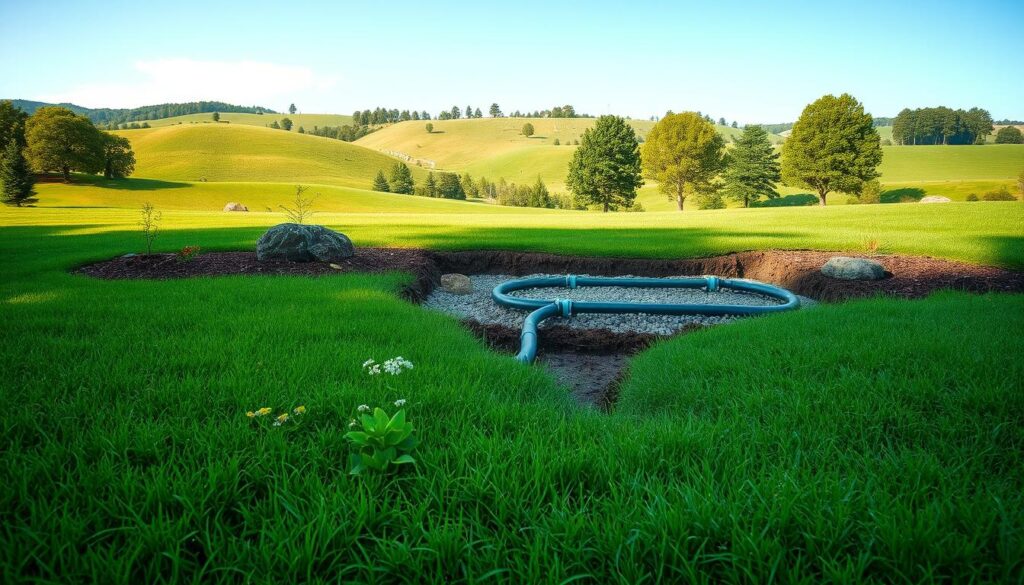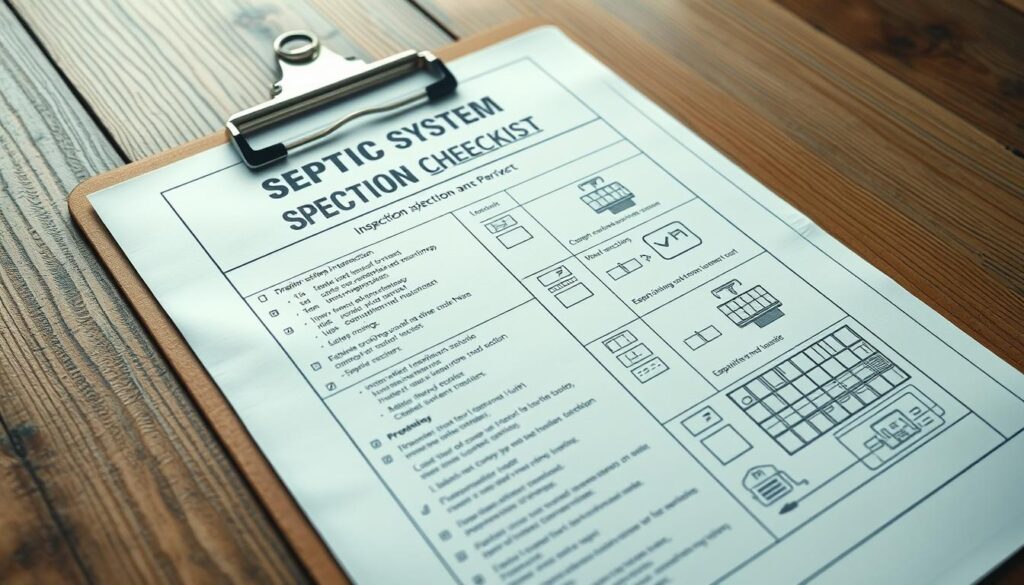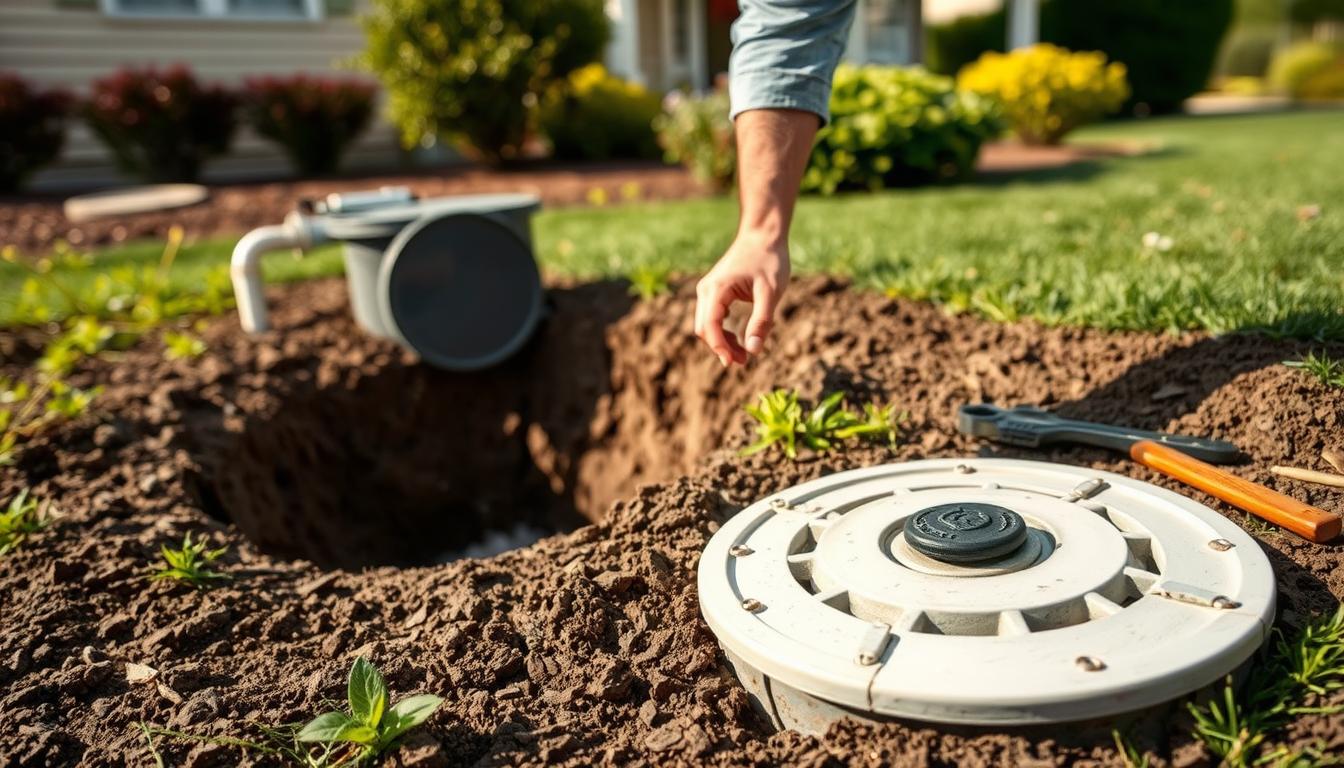As a new homeowner, understanding your septic system is crucial for maintaining a safe and healthy environment. A septic system is a self-contained, underground wastewater treatment system that uses natural processes to treat wastewater, as defined by the EPA.
Proper maintenance is key to extending the life of your septic system and preventing costly repairs. But, do you know the basics of how septic systems work and their importance? In this article, we’ll explore the essential aspects of septic systems and provide you with valuable insights to keep your system running smoothly.
Key Takeaways
- Understanding the basics of septic systems is vital for new homeowners.
- Proper maintenance is crucial for extending the life of your septic system.
- A well-functioning septic system is essential for a safe and healthy environment.
- Regular inspections can help prevent costly repairs.
- Knowing the signs of septic system failure can save you from unexpected expenses.
Understanding the Basics of Septic Systems
As a homeowner with a septic system, grasping the underlying mechanics can help prevent costly repairs and environmental issues. A well-functioning septic system is vital for maintaining a safe and healthy environment around your home.
How Septic Systems Work
A septic system operates by holding wastewater in a tank where solids settle and are broken down by bacteria. The treated wastewater then flows into the drainfield, where it’s filtered through the soil. This natural process is crucial for treating wastewater effectively.
Components of a Typical Septic System
A typical septic system consists of a septic tank and a drainfield. The septic tank is a watertight container that holds wastewater long enough for solids to settle and oils to float to the surface. Understanding these components is key to maintaining your system.
Knowing how your septic system works and its components can help you identify potential issues early on, ensuring your system operates efficiently and effectively.
What New Homeowners Should Know About Septic Systems
As a new homeowner, understanding your septic system is crucial for maintaining your property’s value and ensuring a safe living environment. Unlike municipal sewer systems, septic systems are individual, on-site wastewater treatment systems that require regular maintenance to function properly.
Differences Between Septic and Municipal Sewer Systems
The primary difference between septic and municipal sewer systems lies in their operation and management. Municipal sewer systems are connected to a central treatment facility, whereas septic systems are self-contained and rely on natural processes to treat wastewater. This distinction means that homeowners with septic systems are responsible for their maintenance, including regular inspections and pumping.
Understanding these differences is key to proper septic system care and maintenance. Homeowners should be aware that septic systems require more attention and maintenance compared to municipal sewer systems.
Your Legal Responsibilities as a Septic System Owner
As a septic system owner, you’re legally responsible for its upkeep, which includes maintaining records of inspections, pumping, and maintenance. Failure to comply with local regulations can result in fines and other penalties. It’s essential to familiarize yourself with local laws and regulations regarding septic system maintenance.
Moreover, being aware of common septic system myths debunked can help you make informed decisions about your system’s care. For instance, some believe that septic systems can handle excessive water or that they never need pumping, both of which are misconceptions.
Finding and Identifying Your Septic System
Locating and understanding your septic system’s components is essential for its longevity and efficiency. As a homeowner, knowing where your septic tank and drainfield are located can help you maintain your system properly and avoid costly repairs.
Locating Your Tank and Drainfield
To locate your septic tank and drainfield, start by checking your property’s “as-built” drawings or consulting with a professional. These resources can provide valuable information about your system’s layout. You can also look for signs like manholes or cleanout pipes that indicate the location of your septic tank.
Reading and Understanding Septic System Records
Keeping records of your septic system’s maintenance is crucial. Review your system’s records to understand its history, including when it was installed, inspected, and pumped. This information will help you stay on top of necessary maintenance tasks, such as the recommended septic tank pumping frequency.
| Inspection Item | Frequency | Notes |
|---|---|---|
| Septic Tank Inspection | Every 3-5 years | Check for scum and sludge buildup |
| Drainfield Inspection | Annually | Look for signs of failure like soggy ground |
| System Records Review | Annually | Review maintenance and inspection history |
Essential Septic System Maintenance Tips
Understanding and implementing essential septic system maintenance tips can significantly extend its lifespan. Regular maintenance is key to ensuring your septic system operates efficiently and effectively.
A well-maintained septic system is crucial for a healthy and safe home environment. It involves a combination of regular inspections, pumping, and being mindful of what goes down the drain. By following these maintenance tips, you can prevent costly repairs and replacements.
Recommended Pumping Schedule
Regular pumping is essential to prevent solids from flowing into the drainfield. The frequency of pumping depends on several factors, including the size of your tank and the number of people in your household. Typically, septic tanks should be pumped every 3 to 5 years.
Professional Maintenance vs. DIY Care
While some maintenance tasks can be handled by homeowners, others require professional expertise. It’s recommended to hire a professional for tasks like pumping and inspecting your septic tank. However, you can perform DIY care by being mindful of water usage and avoiding flushing non-biodegradable items.
Seasonal Maintenance Considerations
Different seasons bring different challenges for your septic system. For instance, during heavy rainfall, your drainfield may become saturated, leading to potential backups. In contrast, dry seasons can cause your drainfield to dry out, potentially leading to cracks and other issues. Being aware of these seasonal changes can help you take proactive measures to maintain your septic system.
By following these essential septic system maintenance tips, you can ensure your system runs smoothly, reduce the risk of failures, and prolong its lifespan. Regular care and maintenance are investments in the health and safety of your home and the environment.
Septic Tank Dos and Don’ts
For homeowners with septic systems, being aware of what can and cannot go down the drain is essential. Proper septic tank maintenance involves understanding the dos and don’ts to keep your system running smoothly and prevent costly repairs.
What Can Safely Go Down the Drain
It’s crucial to know what can safely go down your drain to maintain a healthy septic system. Biodegradable materials like human waste, toilet paper, and soap are generally safe. However, it’s essential to be mindful of the quantities and concentrations to avoid overloading your system.
Here’s a simple guide to what can go down the drain:
| Item | Safe Amount | Notes |
|---|---|---|
| Toilet Paper | Moderate | Avoid excessive use |
| Soap | Limited | Prefer biodegradable soap |
| Shower Water | Normal Usage | Be mindful of soap and shampoo |
Products and Substances to Avoid
Certain products and substances can harm your septic system by killing beneficial bacteria or clogging your drainfield. Avoid disposing of non-biodegradable items like sanitary products, wet wipes, and plastics. Harsh chemicals, including drain cleaners and antibacterial soaps, should also be avoided as they can disrupt the balance of your septic system.
To keep your septic system healthy, be cautious about what you put down the drain. Limiting your use of harmful chemicals and avoiding non-biodegradable materials will help maintain the balance of bacteria in your septic tank and ensure your system operates efficiently.
Protecting Your Drainfield
Protecting your drainfield is essential to prevent costly repairs and ensure your septic system functions properly. The drainfield, also known as the leach field, is a critical component of your septic system where wastewater is filtered and treated.

Smart Landscaping Around Your Septic System
When it comes to landscaping around your septic system, being mindful of your drainfield’s location is crucial. Avoid planting trees or shrubs near the drainfield, as roots can infiltrate and damage the pipes, leading to costly repairs. Opt for grass or other shallow-rooted plants that won’t interfere with the drainfield’s operation.
Preventing Physical Damage to Your Drainfield
In addition to careful landscaping, it’s essential to prevent physical damage to your drainfield. Refrain from driving or parking vehicles over the drainfield, as this can compact the soil and reduce its ability to filter wastewater effectively. Similarly, avoid constructing buildings or installing heavy structures over the drainfield, as this can cause significant damage to the pipes and disrupt the system’s functionality.
By taking these precautions and being aware of your drainfield’s location, you can help ensure the longevity of your septic system and prevent potential issues.
Signs of Septic System Problems
Recognizing the warning signs of septic system failure is crucial for homeowners to prevent costly repairs. A septic system that is failing can pose serious health risks and cause significant environmental harm. Being aware of the indicators of potential problems can help homeowners take timely action to mitigate these risks.
Warning Signs You Shouldn’t Ignore
Several signs can indicate that your septic system is experiencing problems. These include:
- Slow drains and gurgling sounds from your plumbing fixtures.
- Unpleasant odors around the house, particularly near the drainfield.
- Lush or soggy vegetation over the drainfield, even during dry weather.
- Sewage backups into your home or yard.
If you notice any of these symptoms, it’s essential to investigate further to determine the cause and appropriate response.
When to Call a Professional Immediately
Some signs require immediate professional attention to prevent further damage or health hazards. These include:
| Signs | Action Required |
|---|---|
| Sewage backups or strong odors | Call a professional immediately to assess and fix the issue. |
| Water pooling in the drainfield | Inspect the system for failure and potential repair needs. |
| Unusual noises or vibrations from the septic tank | Have a professional check the tank and its components. |
By being proactive and addressing these issues promptly, homeowners can avoid more severe problems and ensure their septic system operates effectively.
Complete Septic System Inspection Checklist
A comprehensive septic system inspection is crucial for maintaining the health of your system. Regular inspections help identify potential issues before they become major problems, ensuring your system operates efficiently and effectively.

During a professional inspection, several key components are evaluated to assess the overall condition of your septic system.
What to Expect During a Professional Inspection
A professional inspector will assess the condition of your septic tank, drainfield, and pipes. They will check for signs of leakage, inspect the tank’s inlet and outlet, and evaluate the drainfield’s performance. The inspector will also look for any signs of system failure, such as slow drains or sewage backups.
DIY Monitoring Between Professional Inspections
Between professional inspections, you can monitor your system’s performance by checking for signs of failure, such as unusual odors or soggy soil. Keeping records of maintenance, including pumping schedules and any repairs, is also essential for septic system care and maintenance. By being proactive, you can help extend the life of your septic system and prevent costly repairs.
Using a septic system inspection checklist can guide your DIY monitoring efforts, ensuring you don’t miss critical signs of potential issues.
Septic System Troubleshooting Guide
Effective septic system troubleshooting requires a basic understanding of how the system works and the common issues that can arise. A septic system is a complex process that involves multiple components working together to treat and dispose of wastewater.
To troubleshoot your septic system, you need to be aware of the potential problems that can occur. Common issues include clogs, backups, and failures, which can often be diagnosed through simple checks.
Diagnosing Common Septic Issues
Diagnosing the problem correctly is essential for effective repairs. Start by inspecting your tank’s sludge and scum levels. If the sludge level is too high, it may be necessary to pump the tank. Additionally, check for signs of system failure, such as slow drains, gurgling sounds, or sewage backups.
Simple Fixes vs. Professional Repairs
While some septic system issues can be resolved with simple fixes, others may require professional assistance. For example, if you have a clogged drain, you may be able to clear it using a plunger or plumbing snake. However, more complex problems, such as a failed drainfield, will likely require the expertise of a professional.
Understanding when to attempt a simple fix and when to call a professional is crucial for effective septic system troubleshooting. By being aware of the common issues and knowing how to diagnose them, you can help prevent costly repairs and ensure your system operates efficiently.
Septic System Myths Debunked
Separating fact from fiction is essential when it comes to septic system maintenance. Many homeowners unknowingly follow myths that can harm their septic systems. Understanding the truth behind these misconceptions can help ensure your system operates efficiently and lasts longer.
Common Misconceptions About Septic Care
One common myth is that septic tanks need to be “fed” with additives or special products to function properly. However, most septic systems work just fine without these additives. In fact, the US EPA states that most additives are unnecessary and can even harm your system by disrupting the natural balance of bacteria. Regular pumping and proper maintenance are far more effective.
Another misconception is that you can ignore your septic system as long as it’s not causing problems. Regular inspections are crucial to catch potential issues before they become major problems. Waiting until you notice signs of failure can lead to costly repairs and potential health hazards.
The Truth About Additives and “Miracle” Products
The market is flooded with products claiming to improve septic system performance. These “miracle” products often do more harm than good. They can alter the pH balance of your tank or interfere with the natural breakdown of waste. Instead of relying on these products, focus on proper maintenance practices like regular pumping, being mindful of what you flush, and conserving water.
By understanding the truth behind these myths, you can take better care of your septic system and avoid unnecessary expenses. Proper care and maintenance are key to a functioning septic system.
Conclusion
As a new homeowner, understanding your septic system’s operation and maintenance is crucial for its longevity and effectiveness. By following the guidelines outlined in this article, you can ensure your septic system operates smoothly, preventing costly repairs and maintaining a safe environment for your family.
Proper septic system maintenance tips include regular inspections, pumping the tank as needed, and being mindful of what you put down the drain. The US EPA emphasizes that proper care and maintenance are crucial for the longevity and effectiveness of your septic system.
By being aware of how your septic system works and taking proactive steps to maintain it, you can avoid common issues and ensure a healthy environment. What new homeowners should know about septic systems is that regular maintenance is key to preventing problems and extending the system’s lifespan.

